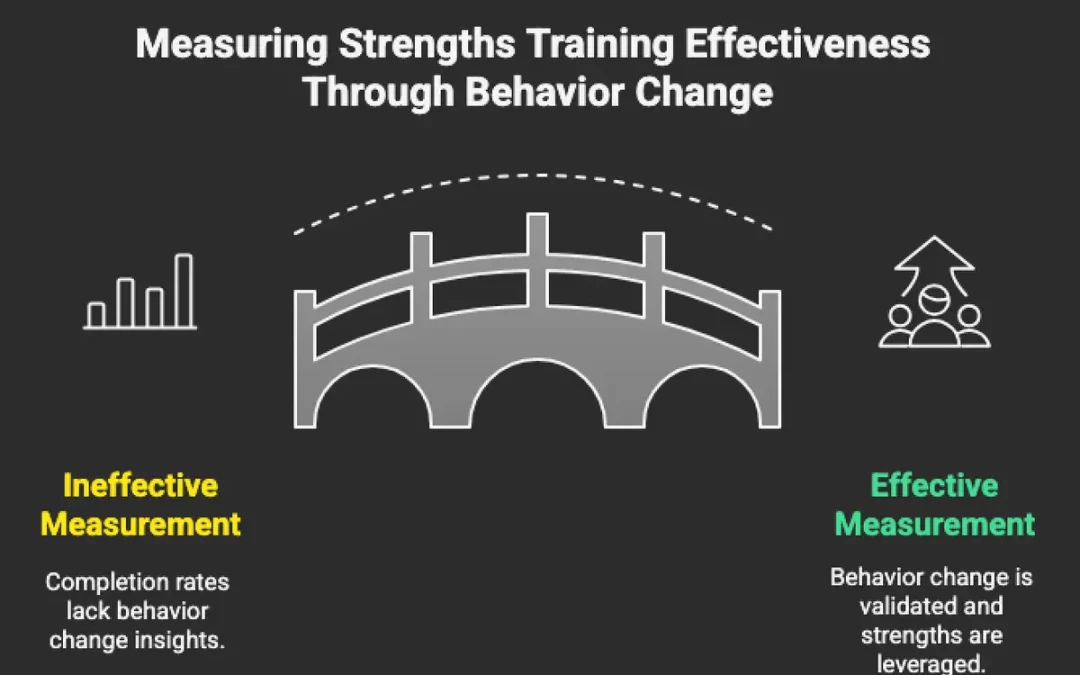Executive Summary: Traditional strengths training metrics (completion rates, satisfaction surveys, self-reports) don’t measure actual behavior change. Instead, track these five indicators: (1) frequency of strengths language in team interactions, (2) role adjustments based on strengths, (3) stakeholder-confirmed behavior changes from 7-10 people, (4) reduction in misalignment friction, and (5) manager capability in strengths-based conversations. Cross-reference self-reports with external validation because 95% of people think they’re self-aware but only 10% actually are.
Why You Can’t Answer the CEO’s Simple Question
Six months after investing in strengths-based development for your team, the CEO walks into your office with one question: “Did it work?”
You pull up the completion rates. Everyone finished the training. Satisfaction scores were high. Knowledge tests showed people understood their strengths.
But here’s what you can’t answer: Are people actually using their strengths? Is performance improving? Was any of this worth the investment?
The metrics you’re tracking tell you nothing about what matters.
Why Don’t Completion Rates and Satisfaction Surveys Measure Real Change?
The Problem: Completion rates, satisfaction surveys, and knowledge tests measure exposure to training content, not behavioral change or performance improvement.
Most organizations measure training the same way they measure compliance programs. Did people show up? Did they pass the test? Are they satisfied?
These metrics measure exposure, not impact.
When we complete our Personal Style Indicator, people get immediate insights about their natural predispositions. A 15-year-old can understand their personality profile in minutes. The awareness is instant.
But awareness and application are completely different things.
Example: You can know that you are a task oriented individual (not people) – but that does not mean you are aware not to book back-to-back meetings with lots of people that will drain your energy.
You can identify that detail orientation isn’t your strength. That doesn’t mean you’ll delegate the financial reporting that’s killing your motivation.
The gap between knowing and doing is where most strengths training dies.
Research confirms this disconnect. While strengths-based development shows that 67% of employees are engaged when managers focus on their strengths versus only 2% when they don’t, most organizations never measure whether managers are actually doing this.
How Reliable Are Self-Reported Strengths Metrics?
Key Finding: 95% of people believe they’re self-aware, but only 10% actually are. This gap makes self-reported strengths utilization metrics almost worthless.
Here’s the reality that makes measurement even harder.
Think about what that means for your measurement system.
If you ask people “Are you using your strengths?” most will say yes. They genuinely believe they are. But their perception doesn’t match how others experience them.
We worked with a manager who was certain she was empowering her team by giving them autonomy. When we gathered stakeholder feedback from seven team members, the consistent theme was clear: they felt micromanaged, demoralized, and disrespected.
Her self-perception was completely disconnected from her actual impact.
This is why self-awareness research shows that un-self-aware colleagues can cut a team’s chances of success in half.
Self-reported metrics about strengths utilization are almost worthless.
You need external validation, not internal perception.
What Should You Actually Measure to Prove Strengths Training ROI?
To measure whether strengths-based development is working, track these five evidence-based indicators at the six-month mark:
1. Is Your Team Actually Using Strengths Language Daily?
What to measure: How often strengths vocabulary appears in meetings, one-on-ones, and decision-making conversations.
Is the vocabulary from the training showing up in these interactions?
If people aren’t referencing their strengths profiles, they’re not using them.
This isn’t about forced adoption. It’s about whether the framework became part of how the team thinks and communicates.
2. Are People Restructuring Work Based on Their Strengths?
What to measure: Number of documented work restructures where people shifted responsibilities to align with their natural predispositions, plus manager-initiated task redistributions based on team strengths assessments.
Concrete changes in work allocation indicate real application beyond awareness.
Fred, the CEO of a credit union we worked with, made the Personal Style Indicator a cultural norm. Every single person in that 300-person organization completed it. He brought it into every management meeting. When he had one-on-ones with managers, he’d pull out both profiles and discuss connection points and differences.
Ten years later, he’d built that credit union into a billion-dollar organization. The insight was immediate. The application was sustained. The results took a decade.
3. What Are Colleagues Saying About Behavior Changes?
What to measure: Aggregated feedback from 7-10 colleagues who interact with each participant regularly, focusing on consistent behavioral themes.
This is the most critical validation metric.
Aggregate feedback from multiple people who interact with each participant regularly. Look for consistent themes about what’s different.
One person saying someone changed means nothing. Seven people noticing the same shift means something real is happening.
We don’t ask vague questions like “How are they doing?” We ask specific ones:
“What’s one behavior you’ve noticed changing?”
“Where do you still see old patterns showing up?”
We also track self-reported daily indicators, but here’s the key: we cross-reference them with stakeholder feedback.
When someone says “I listened better in meetings this week” and their team confirms “yes, they’re actually letting us finish sentences now,” you know application is happening.
When self-perception and external feedback don’t match, you know someone is checking boxes without changing.
4. Are You Seeing Less Role Misalignment Conflict?
What to measure: Decreased conflicts from role-personality mismatches, reduced frustration from detail-oriented people in big-picture roles (or vice versa), and fewer complaints about energy-draining work assignments.
Declining misalignment friction is a leading indicator of effective strengths utilization.
When someone with a value of tranquility is stuck in a conflict-heavy role, their soul erodes. When a big-picture thinker is drowning in spreadsheets, their energy tanks.
Strengths training should reduce these mismatches. If it doesn’t, people learned about their strengths but didn’t act on them.
5. Can Your Managers Actually Lead Using Strengths?
What to measure: Manager ability to articulate each team member’s specific strengths, evidence of strengths-focused development conversations, and documented staffing decisions that reference strengths profiles.
If managers can’t demonstrate these capabilities, the training didn’t transfer to the people who drive team performance.
With employee engagement at its lowest point in a decade at just 31%, the organizations that actually measure and sustain strengths-based development have a massive competitive advantage.
But only if they’re measuring the right things.
How Do You Report Strengths Training ROI to Your CEO?
The Six-Month Reality Check:
When the CEO asks if the training worked, the honest answer at six months is: “We’re tracking the right indicators, and here’s what they show.”
You show frequency of application. You show stakeholder-confirmed changes. You show role adjustments. You show reduced misalignment friction. You show manager capability.
You don’t pretend transformation is complete. You show evidence that it’s progressing.
The insight happens fast. The results take time. The measurement tracks both.
That’s how you measure strengths-based development without lying to yourself or your CEO.
Because completion rates and satisfaction scores will always be high. The question is whether anything actually changed.
And the only way to know that is to measure what matters: consistent application of accurate self-awareness in daily decisions, validated by the people who experience the impact.
Everything else is just checking boxes.
What Are the Key Metrics That Actually Matter?
Bottom line: Stop measuring training completion. Start measuring behavioral application.
The five metrics that matter:
- Strengths language frequency in daily operations
- Documented role adjustments aligned with strengths
- Multi-stakeholder validated behavior changes
- Decreased role misalignment conflicts
- Manager proficiency in strengths-based leadership
Cross-reference self-reports with external validation. Track progressive application over 6-18 months, not just completion rates.
Because knowing your strengths and using your strengths are two completely different things.

